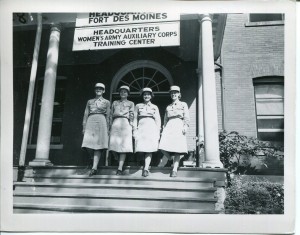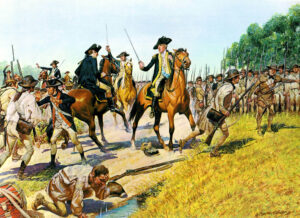Major General Benedict Arnold, bitter at the delay of a court-martial for charges of profiteering, sends a letter to the British offering his services. A series of letters is exchanged in which Arnold negotiates his price.

Major General Friedrich Wilhelm von Steuben, having served as the Army’s Inspector General and an aide to General George Washington without pay, resigns. Congress rewards him by awarding him a gold-hilted sword and a pension.
George Washington is inaugurated as the first President and Commander-in-Chief of the Army and Navy.
Due to the Quasi-War with France, Congress increases Army strength. A separate regiment of artillerists and engineers is authorized, along with the enlistment of a “Provisional Army” of 10,000 men for three years’ service.

William Clark of the Corps of Discovery receives a lieutenant’s commission with captain’s pay. Clark accepts it, and Captain Meriwether Lewis assures him they will continue as “captains and co-commanders.” Clark is promoted to captain by Congress in 2000, 196 years after his commission.
The 1st, 2d, and 3d Artillery Regiments are consolidated to form a single Corps of Artillery with twelve independent battalions. The Regiment of Light Artillery remains separate. The 1st and 2d Light Dragoons are consolidated into the 1st Light Dragoon Regiment. Three new regiments of riflemen are authorized for five years or “duration” of the War of 1812.
The Army Corps of Engineers begins surveying the route of the Chesapeake and Ohio Canal. The canal is completed in 1850.
Major General Alexander Macomb signs a peace treaty with Seminole Indians and announces “victory” in the Second Seminole War, leaving several days later for Washington. Fighting resumes on 23 July.
Colonel William W. Loring departs Jefferson Barracks, Missouri, for Oregon Territory with the Regiment of Riflemen to establish posts along the Oregon Trail to protect settlers moving west.
Lieutenant John Davidson and Company I, 1st Dragoons, are ambushed at Cieneguilla, New Mexico Territory, by Chacon of the Jicarilla Apaches. The dragoons, outnumbered four to one, fight for three hours before being able to retreat.

Major General George G. Meade’s Army of the Potomac and General Robert E. Lee’s Army of Northern Virginia clash in an area called The Wilderness near the Chancellorsville battlefield, with inconclusive results. Casualties are heavy: the Union losses number approximately 18,000 killed, wounded, and missing; Confederate casualties total 10,800.
The 332d Infantry returns to the United States after eight months in Italy. It is the only U.S. combat unit to serve in Italy during World War I.
The 332d Infantry returns to the United States after eight months in Italy. It is the only U.S. combat unit to serve in Italy during World War I.

George Herman (Babe) Ruth joins the New York National Guard as a private in the 104th Field Artillery. He continues to play baseball after his enlistment.
Major General Joseph Green is named Chief of Coast Artillery and will be the last officer to service in this assignment. This position is eliminated soon after the attack on Pearl Harbor.

U.S. paratroopers from the 82d and 101st Airborne Divisions drop into Normandy, France, as part of the Allies’ Operation OVERLORD. They are followed by amphibious landings that include troops from the U.S. 1st, 4th, and 29th Infantry Divisions, Rangers, and various other units.

A treaty establishing the North Atlantic Treaty Organization (NATO) is signed, committing the signatories to the mutual defense of Western Europe. The U.S. Senate ratifies the treaty 83-12, marking the first time the United States has entered a military alliance in peacetime.
The Army’s first helicopter battalion, the Transportation Battalion (Helicopter), is activated at Fort Bragg, North Carolina.
In the Vietnam War’s heaviest fighting to date, Viet Cong forces kill four American advisors and 250 South Vietnamese soldiers and local militia in the Mekong Delta.

First Lieutenant Sharon Ann Lane is killed by a rocket attack on the 312th Evacuation Hospital at Chu Lai. She is one of eight female nurses to die in Vietnam, and the only one killed by hostile fire. She is posthumously awarded the Bronze Star.

Second Lieutenant Sally W. Murphy graduates from Army flight school, becoming the Army’s first female helicopter pilot.

The 101st Airborne Division becomes the first unit to be equipped with the UH-60 Black Hawk helicopter, replacing the Bell UH-1 Huey.
Colonel James N. Rowe, chief of the Army branch of the Joint United States Military Advisory Group providing counterinsurgency training to the Philippine military, is assassinated by Marxist guerillas in Quezon City.
NATO ground troops move into Kosovo, including Task Force Falcon, the American contingent. This marks the beginning of the Kosovo Defense Campaign.
Specialist Michelle Witmer of the 32d Military Police Company is killed by an improvised explosive device. She is the first female National Guard soldier to be killed in action, and the first Wisconsin National Guard soldier to die in combat since World War II.

General Stanley McChrystal becomes commander of International Security Assistance Forces in Afghanistan.
President Barack Obama announces a timetable for withdrawing most U.S. forces from Afghanistan by the end of 2016. U.S. forces will not fully withdraw until 2021.



